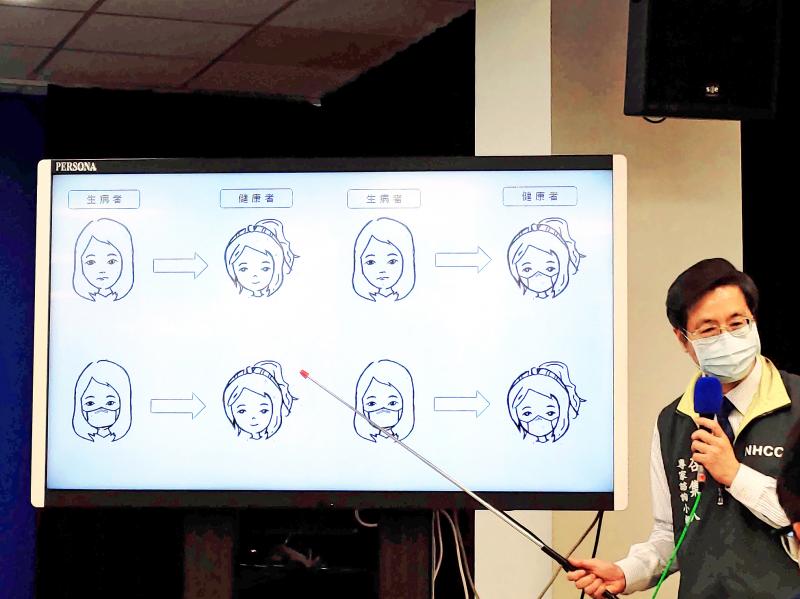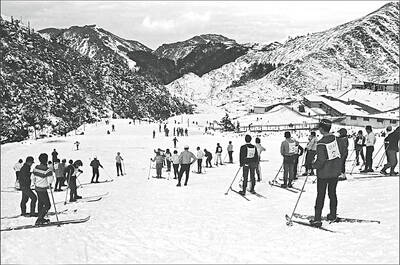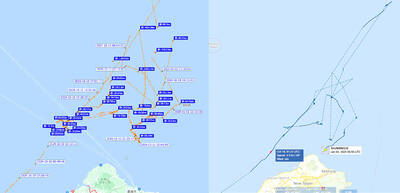Wearing masks greatly reduces the risk of spreading COVID-19, Central Epidemic Command Center (CECC) specialist advisory panel convener Chang Shan-chwen (張上淳) said.
Chang made the remark at the center’s daily news conference on Saturday.
“Many people have asked why several confirmed cases in Taiwan did not spread the virus to other people,” Chang said, pointing to an illustration depicting a healthy person and an infected person interacting in possible scenarios.

Photo: Wu Liang-yi, Taipei Times
He said that the risk of infection is high if both are not wearing masks, but if only the healthy person wears a mask, the risk of contracting COVID-19 through respiratory droplets is greatly reduced — possibly by as much as 50 to 80 percent.
If only the infected person wears a mask, the spread of the virus through droplets might be reduced by about 80 to 90 percent, with a risk of leakage from the sides of the mask, he said.
When both wear a mask, the risk of transmission is significantly reduced to about 1 to 2 percent, he added.
Discussing the eight cases reported at a hospital in February, Chang said that the infected person (the nation’s 34th confirmed case) had difficulty breathing, so she sometimes did not wear a mask, and might have contaminated the environment.
Chang also addressed the epidemiological characteristics of the nation’s suspected and confirmed cases — a total of 63,340 between Jan. 15 and Thursday last week.
Taiwan reported zero cases for six consecutive days ending on Friday, with three cases reported on Saturday.
“We issued travel warnings for many countries in mid-March and travelers returning from those countries with symptoms were reported upon arrival in Taiwan, so the numbers of daily reported suspected cases significantly increased from mid-March, and gradually reduced as very few travelers have arrived in the past few weeks,” he said.
The numbers of daily confirmed cases indicate a similar trend, showing that the peak of reported cases was in mid-March, he said.
Among the symptoms reported by the 429 infected people when they were tested, 51 percent reported coughing, 45 percent had a fever, 25 percent had a stuffy or runny nose, 17 percent had an abnormal sense of smell and 10 percent had an abnormal sense of taste, Chang said.
Doctors’ clinical diagnoses of the first 100 confirmed cases show that the two most common symptoms were fever and coughing, he said.
Of those cases, 54 percent had a fever, 54 percent were coughing, 35 percent had throat pain, 27 percent had stuffy or runny noses, 25 percent had fatigue, 14 percent had sore muscles, 10 percent had diarrhea, 10 percent had headaches, 10 percent had an abnormal sense of smell or taste, and 2 percent had nausea or were vomiting.
“Twenty-four people have used or are using ventilators as previously reported, including the six who died,” Chang said. “The number of people who are now on ventilators dropped from 10 to six this week, meaning that 12 people have been taken off a ventilator after recovery.”
Since April 20, the number of COVID-19 patients who have been discharged from hospitals after treatment exceeded those who are being hospitalized, he said.
In response to a question about why the number of cases confirmed on the navy supply ship Panshih (磐石) was lower than in similar incidents in other nations, he said that the people on board who had a fever were told to stay in the ship’s sick bay until their fever subsided and to wear a mask when they returned to their post.
“We don’t know if they conformed to the order to wear masks at all times, but if the infected people wore a mask, the healthy crew members wore a mask or if they all wore masks at least some of the time, the risk of viral transmission would still be significantly reduced,” Chang said.

DEEPER REVIEW: After receiving 19 hospital reports of suspected food poisoning, the Taipei Department of Health applied for an epidemiological investigation A buffet restaurant in Taipei’s Xinyi District (信義) is to be fined NT$3 million (US$91,233) after it remained opened despite an order to suspend operations following reports that 32 people had been treated for suspected food poisoning, the Taipei Department of Health said yesterday. The health department said it on Tuesday received reports from hospitals of people who had suspected food poisoning symptoms, including nausea, vomiting, stomach pain and diarrhea, after they ate at an INPARADISE (饗饗) branch in Breeze Xinyi on Sunday and Monday. As more than six people who ate at the restaurant sought medical treatment, the department ordered the

A strong continental cold air mass and abundant moisture bringing snow to mountains 3,000m and higher over the past few days are a reminder that more than 60 years ago Taiwan had an outdoor ski resort that gradually disappeared in part due to climate change. On Oct. 24, 2021, the National Development Council posted a series of photographs on Facebook recounting the days when Taiwan had a ski resort on Hehuanshan (合歡山) in Nantou County. More than 60 years ago, when developing a branch of the Central Cross-Island Highway, the government discovered that Hehuanshan, with an elevation of more than 3,100m,

Taiwan’s population last year shrank further and births continued to decline to a yearly low, the Ministry of the Interior announced today. The ministry published the 2024 population demographics statistics, highlighting record lows in births and bringing attention to Taiwan’s aging population. The nation’s population last year stood at 23,400,220, a decrease of 20,222 individuals compared to 2023. Last year, there were 134,856 births, representing a crude birth rate of 5.76 per 1,000 people, a slight decline from 2023’s 135,571 births and 5.81 crude birth rate. This decrease of 715 births resulted in a new record low per the ministry’s data. Since 2016, which saw

SECURITY: To protect the nation’s Internet cables, the navy should use buoys marking waters within 50m of them as a restricted zone, a former navy squadron commander said A Chinese cargo ship repeatedly intruded into Taiwan’s contiguous and sovereign waters for three months before allegedly damaging an undersea Internet cable off Kaohsiung, a Liberty Times (sister paper of the Taipei Times) investigation revealed. Using publicly available information, the Liberty Times was able to reconstruct the Shunxing-39’s movements near Taiwan since Double Ten National Day last year. Taiwanese officials did not respond to the freighter’s intrusions until Friday last week, when the ship, registered in Cameroon and Tanzania, turned off its automatic identification system shortly before damage was inflicted to a key cable linking Taiwan to the rest of